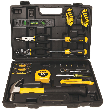Building a sandbox is easier and less expensive than you would think. All the materials and tools necessary to build one are either already located around the home, or can easily be purchased from any local home improvement store.
To begin this project you are going to need to do two things. First, begin your work on a clear sunny day, where you are going to have plenty of time to complete your project, which should take roughly four hours to complete. Second, make sure that you have all of the materials and equipment to complete the task. The dimensions and quantities listed here are for a 64 square-foot sandbox. You can use whatever combination of dimensions you wish, but keep in mind you might have to make some adjustments in the measurements given here.
- Weed fabric
- 12 2-inch Screws
- 24 2-1/2-inch Screws
- 4 wooden boards 8' x 8', 1-inch thick
- 4 wooden blocks 2" x 2", 1-foot long
- 8 wooden blocks 2" x 1", 1-foot long
- 32 cubic feet of play or river sand (65 fifty-pound bags)
- Staple gun
- Twine and stakes
- Garden rake
- Shovel
- Level
- Pencil and paper
- Drill
- Drill bits
- Wheelbarrow
After you have collected the list above, you are ready to begin. There are a total of 3 steps in this project, and as long as you have the time and energy you are going to be able to complete the project in one day.
- Plan and Prepare. The location of your sandbox is going to be important. Select a level area of your yard that has as much shade as possible. Level because it is easier to prepare a level area, and shady because your children are going to be playing outside and this can help avoid sunburns. Once you have selected your location, take your stakes, twine and level and start to lay out the physical spot for your sand box and mark of a square that is roughly 8-1/4 foot on each side with the stakes and twine. While we are going to be making a sandbox that is 8' x 8', the extra 3" on each side is going to ensure an easier time of assembly and insertion. Once the boundaries have been properly marked begin removing all the sod and dirt within the square down to a depth of one foot, using the wheelbarrow and shovel. Do not dispose of all the dirt since you are going to replace some of it along the outside edges of the completed box. Now cut out from the weed fabric, a square patch that measures 9' x 9', and set aside.
- Assembly. Start laying out the 8' x 8' boards to one side of the hole. Starting at one corner, place a 2'x2' block inside the corner. On each side of the corner, using your drill, evenly space and drill in 3, 2" screws. Repeat at each corner of the sandbox. Once you have the corners made, halfway down on each side, place two of the 2" x 1" blocks on either side of the wall. Using three 2-1/2-inch screws on each side, attach the support blocks. After you have assembled the walls, pull the weed fabric and place over the top. Pull the material snug on one side and attach using the staple gun. Repeat all around the walls, and you should not have any left hanging over the sides, this material has now formed the bottom, while also helping to prevent any weeds growing from the soil into the sand box. Insert the sandbox into the hole, being careful not to tear any of the material. Refill the exterior edges of the sandbox with some of the dirt.
- Sanding. Once you have assembled and placed the box, you can begin to fill it up. Simply dump out each of the bags of play/river sand into the box. After every fifth bag, gently redistribute the sand using the flat edge of your garden rake. Once you have finished filling the sandbox, clean up and you are done.
Author Bio
Lee Wyatt
Contributor of numerous Tips.Net articles, Lee Wyatt is quickly becoming a regular "Jack of all trades." He is currently an independent contractor specializing in writing and editing. Contact him today for all of your writing and editing needs! Click here to contact. Learn more about Lee...
Washing Black Clothes
You would think that washing black clothes would be a fairly simple prospect. After all, it's only logical that dirt or ...
Discover More
What is Grafting?
If you have been around nurseries and tree farms then chances are fairly good that you have at least heard of the term ...
Discover More
Restoring Dull and Faded Wood Furniture
Wood furniture can add a wonderful touch of elegance to just about any home. However, over time most wood furniture can ...
Discover More
More Home Improvement Tips
Cabinet, Counters, and Storage Tool Kit
Some of the more important parts of the home are things like cabinets, counters and other types of storage spaces. As ...
Discover More
Installing a Garage Door
Installing a garage door is a perfect weekend project that even the most inexperienced of home improvement enthusiasts ...
Discover More
Building a Bookcase
If you love to read, are looking for a little more storage or simply want a little practice at carpentry, then why not ...
Discover More

Comments